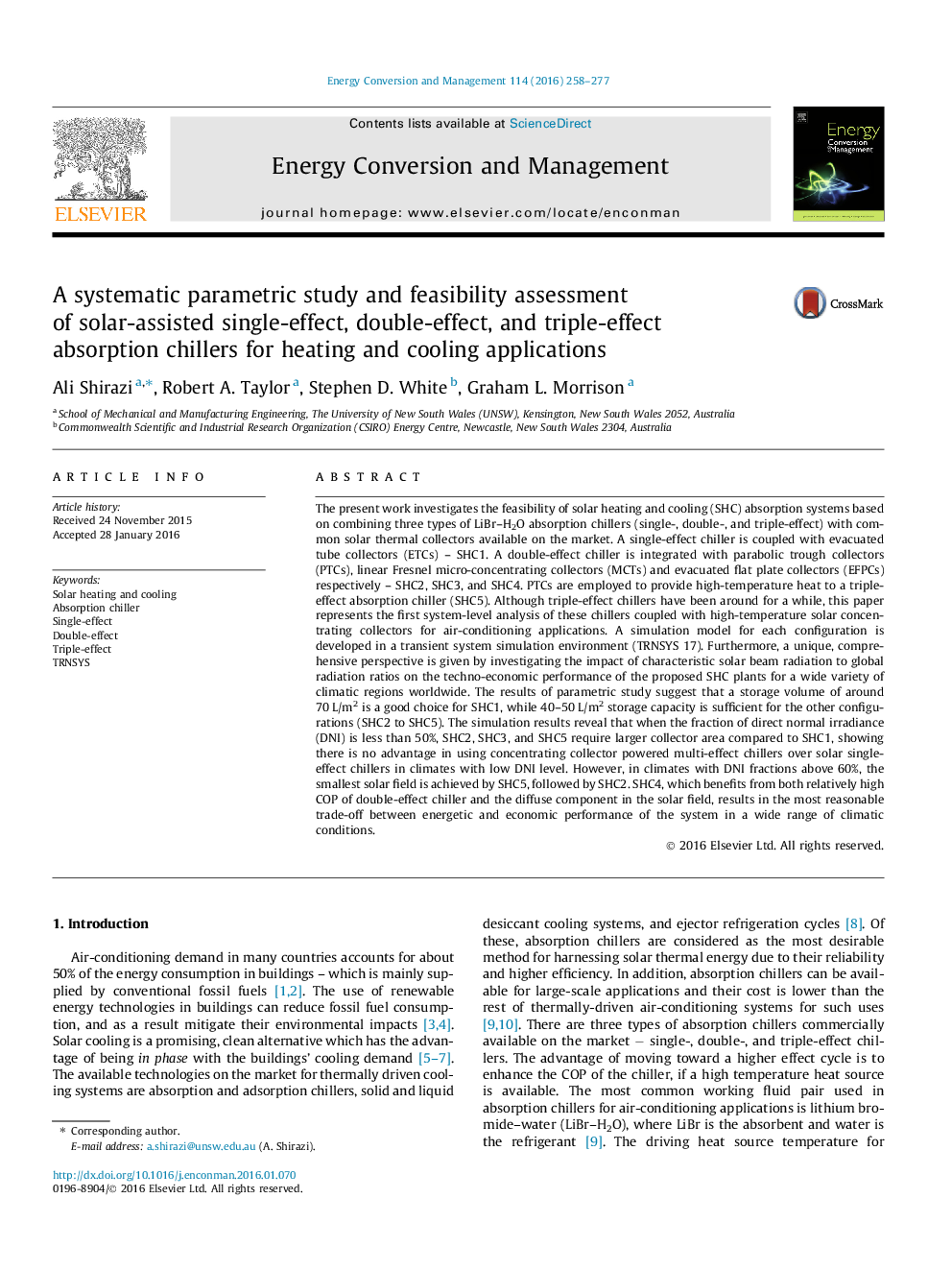| کد مقاله | کد نشریه | سال انتشار | مقاله انگلیسی | نسخه تمام متن |
|---|---|---|---|---|
| 7161039 | 1462848 | 2016 | 20 صفحه PDF | دانلود رایگان |
عنوان انگلیسی مقاله ISI
A systematic parametric study and feasibility assessment of solar-assisted single-effect, double-effect, and triple-effect absorption chillers for heating and cooling applications
ترجمه فارسی عنوان
یک مطالعه پارامتریک سیستماتیک و ارزیابی امکان تأمین انرژی خورشیدی با استفاده از خورشید تک اثر، اثر دوگانه و چیلر جذب سه گانه برای کاربردهای گرمایشی و سرد
دانلود مقاله + سفارش ترجمه
دانلود مقاله ISI انگلیسی
رایگان برای ایرانیان
کلمات کلیدی
موضوعات مرتبط
مهندسی و علوم پایه
مهندسی انرژی
انرژی (عمومی)
چکیده انگلیسی
The present work investigates the feasibility of solar heating and cooling (SHC) absorption systems based on combining three types of LiBr-H2O absorption chillers (single-, double-, and triple-effect) with common solar thermal collectors available on the market. A single-effect chiller is coupled with evacuated tube collectors (ETCs) - SHC1. A double-effect chiller is integrated with parabolic trough collectors (PTCs), linear Fresnel micro-concentrating collectors (MCTs) and evacuated flat plate collectors (EFPCs) respectively - SHC2, SHC3, and SHC4. PTCs are employed to provide high-temperature heat to a triple-effect absorption chiller (SHC5). Although triple-effect chillers have been around for a while, this paper represents the first system-level analysis of these chillers coupled with high-temperature solar concentrating collectors for air-conditioning applications. A simulation model for each configuration is developed in a transient system simulation environment (TRNSYS 17). Furthermore, a unique, comprehensive perspective is given by investigating the impact of characteristic solar beam radiation to global radiation ratios on the techno-economic performance of the proposed SHC plants for a wide variety of climatic regions worldwide. The results of parametric study suggest that a storage volume of around 70Â L/m2 is a good choice for SHC1, while 40-50Â L/m2 storage capacity is sufficient for the other configurations (SHC2 to SHC5). The simulation results reveal that when the fraction of direct normal irradiance (DNI) is less than 50%, SHC2, SHC3, and SHC5 require larger collector area compared to SHC1, showing there is no advantage in using concentrating collector powered multi-effect chillers over solar single-effect chillers in climates with low DNI level. However, in climates with DNI fractions above 60%, the smallest solar field is achieved by SHC5, followed by SHC2. SHC4, which benefits from both relatively high COP of double-effect chiller and the diffuse component in the solar field, results in the most reasonable trade-off between energetic and economic performance of the system in a wide range of climatic conditions.
ناشر
Database: Elsevier - ScienceDirect (ساینس دایرکت)
Journal: Energy Conversion and Management - Volume 114, 15 April 2016, Pages 258-277
Journal: Energy Conversion and Management - Volume 114, 15 April 2016, Pages 258-277
نویسندگان
Ali Shirazi, Robert A. Taylor, Stephen D. White, Graham L. Morrison,
